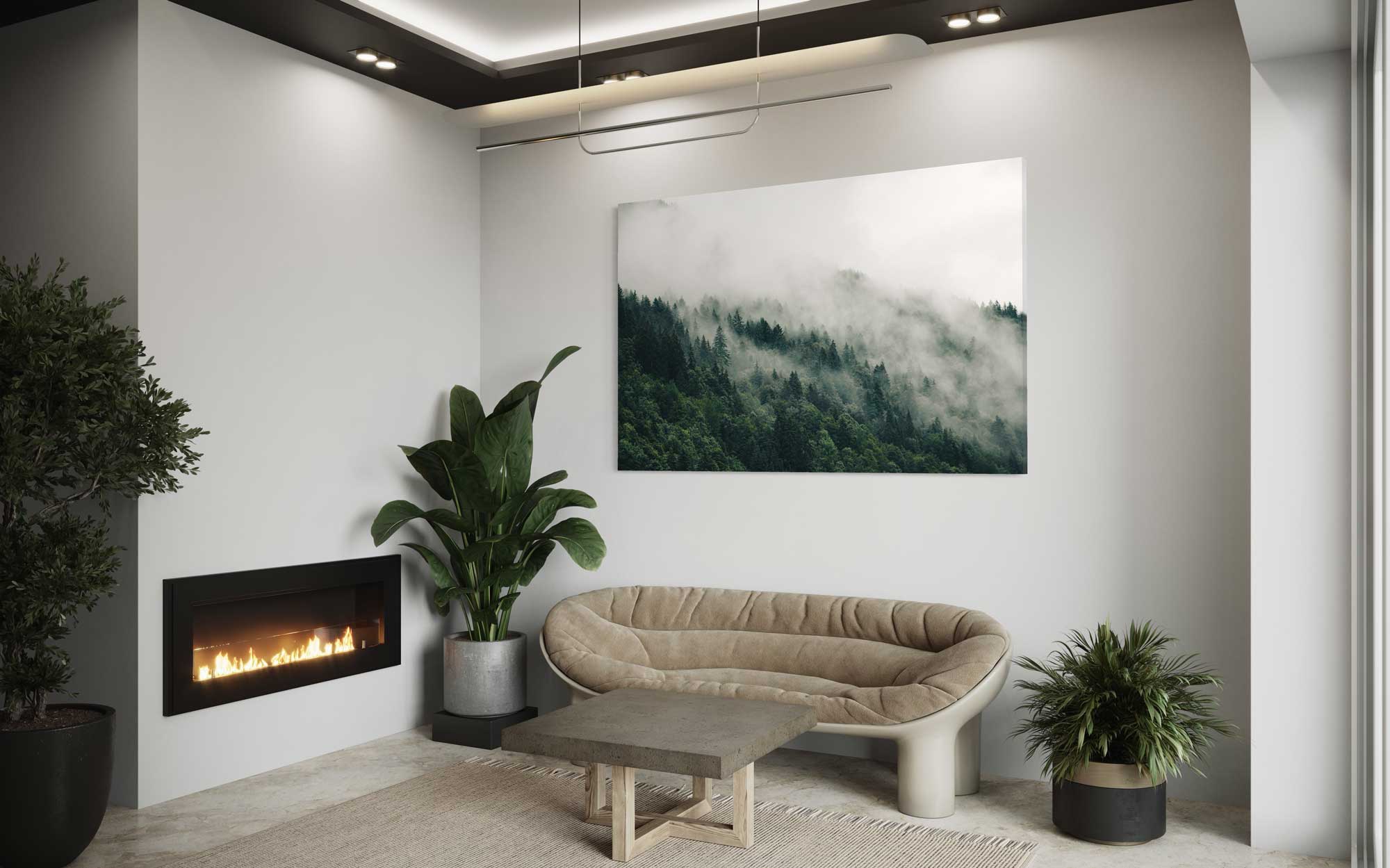
Acrylic Prints vs. Canvas Prints: Which Medium Best Suits Your Images?
Introduction to Print Mediums: Understanding Acrylic and Canvas
The visual arts have been perpetually evolving, and with this metamorphosis, the mediums to display imagery have diversely expanded. Central to the conversation are acrylic and canvas prints, each offering a distinctive set of characteristics and aesthetic appeals.
Acrylic prints are celebrated for their sleek, modern look and durability. The process involves printing images directly onto acrylic material or encapsulating photographic prints between sheets of clear acrylic. This medium is known for:
- Vibrancy: Enhanced colour sharpness and saturation due to the glossy finish and excellent light reflection.
- Depth Perception: A remarkable sense of depth, as the transparent layer adds a three-dimensional look.
- Durability: Resistance to moisture and UV rays, which safeguards the artwork against fading over time.
On the other hand, canvas prints evoke a traditional, classic feel that has been cherished in the art world for centuries. Modern canvas prints are created by printing images onto canvas fabric, which is then stretched over a frame. Canvas offers several inherent benefits:
- Texture: The fabric grants the artwork a tactile quality and an impression of an original painting.
- Glare Reduction: The matte surface minimises light reflection, making it ideal for rooms with variable lighting.
- Versatility: Lightweight and adaptable to various frame options or gallery wrapping.
When selecting the right print medium for an image, one must assess the desired aesthetic outcome, the environmental conditions where the artwork will be displayed, and the longevity expected of the piece. Acrylic and canvas each respond differently to these considerations, underscoring the importance of understanding their distinct properties before making a choice.
Acrylic Prints Explained: Characteristics and Benefits
Acrylic prints offer a modern, sleek aesthetic that enhances the quality of images with their unique set of characteristics and benefits.
- Vibrancy and Colour Depth: Acrylic's glossy surface amplifies colours, giving prints a more vibrant and dynamic feel. The colours within acrylic prints are more vivid and the details sharper than traditional printing media. This is due to the excellent light refractive qualities of acrylic, which create a 3D effect and make the images pop, particularly when backlit.
- Durability and Longevity: Unlike canvas, acrylic is resistant to moisture and UV light, meaning that your prints are less likely to fade over time. This makes acrylic a great choice for bright, sunlit rooms where exposure to natural light is significant. The material is also shatter-resistant and can endure more handling than traditional framed prints, which is beneficial for display in high-traffic areas.
- Clean, Frameless Presentation: Acrylic prints often come with a sleek, frameless design that lends itself to a contemporary aesthetic. This minimalist look can complement a wide range of decor styles and doesn't detract from the visual impact of the image itself.
- Versatility in Display Options: They can be mounted in various ways, from standoffs to floating mounts, giving additional dimension to the wall space. This versatility is ideal for curated interior designs and can be adapted as trends change over time.
- Ease of Maintenance: Acrylic prints are also straightforward to maintain. Dust and fingerprints can be easily wiped away with a soft, damp cloth without damaging the print—convenient for both home and public spaces.
In essence, acrylic prints are suited for photographers and artists who wish to exhibit their work with a modern edge and lasting durability. The fusion of high-definition clarity, robustness, and flexibility makes acrylic an excellent medium for visually striking images.
Canvas Prints Unveiled: Features and Aesthetic Appeal
Canvas prints stand as a testament to art's evolutionary journey through technology and traditional methods. While acrylic prints gleam with modernity, canvas prints speak to the time-honoured aesthetic preferred in classic art galleries.
- Texture and Depth: Canvas prints offer a distinctive texture that can add depth and a tactile quality to images. The fabric weave not only enhances the overall look but also introduces an element of physicality that is often missing in sleeker mediums.
- Colour Absorption: Unlike the glossy surface of acrylic, canvas absorbs light, reducing glare and allowing colours to stand more subdued and natural. This makes them excellent for viewing under various lighting conditions without the worry of reflection distorting the image.
- Versatility: The adaptability of canvas prints caters to a variety of photographic styles, from portraits to landscapes. It complies well with both black and white and colour images, providing a gentle, artistic flair that suits a multitude of decors.
- Finish Options: A canvas print does not necessitate glass for protection, thus offering a matte or a satin finish that is approachable and avoids the clinical feel that can come from behind a glass pane.
- Durability: High-quality canvas prints can be quite durable. The combination of advanced printing techniques and protective coatings means they can resist fading and withstand the test of time.
- Gallery-Wrapped Edges: Many canvas prints are gallery-wrapped, where the image extends around the sides of the stretcher frame, creating a contemporary display that doesn't always require additional framing.
The aesthetic appeal of canvas lies in its homeliness and classic vibe. It is a medium that invokes nostalgia while still residing comfortably in modern interiors. Canvas prints provide a certain richness and warmth, inviting viewers to reach out and touch the art, making it an inclusive and interactive experience.
The Durability Factor: Longevity of Acrylic vs. Canvas
When considering the longevity of acrylic versus canvas prints, one must take into account several environmental and material factors that contribute to the durability of these mediums.
Acrylic prints offer a modern look with a sleek, glossy finish that can make images appear more vibrant and detailed. They are printed onto a cast acrylic sheet, allowing for greater colour saturation and precision. Durability-wise, acrylic prints are highly resistant to moisture and UV light, helping prevent fading over time. This makes them well-suited for areas with high exposure to sunlight or humidity. Moreover, they are scratch-resistant and can be easily wiped clean with a soft cloth, ensuring their longevity in a variety of settings.
On the contrary, canvas prints provide a classic, textured look that can add depth and an artistic touch to images. The canvas, typically made from cotton or linen, is more susceptible to environmental elements. While most canvas prints come with a UV-protective coating to mitigates some of the risks, they are still more likely to fade over time compared to acrylic, especially if exposed to direct sunlight. Additionally, canvas prints can be more vulnerable to physical damage and are more challenging to clean, requiring careful dusting and avoidance of moisture.
In summary, while both mediums can last for decades with proper care, acrylic prints generally offer a higher level of durability and protection against environmental factors, making them a more robust choice for prints that need to withstand the test of time. Canvas prints, while not as resilient, can still maintain their integrity for many years given they are displayed and maintained correctly.
Print Quality and Clarity: Comparing Image Fidelity on Different Mediums
When assessing print quality and clarity between acrylic and canvas prints, it is vital to consider how each medium affects the image fidelity of your photos or artworks.
In the realm of acrylic prints, the most striking attribute is their luminous quality. The superior clarity of acrylic material allows for a near glass-like finish, giving a vibrancy and depth to the image that canvas prints often cannot match. Acrylic prints are characterised by:
- Sharpness in detail, showcasing minute features with crispness.
- Enhanced colour saturation, making them intensely vivid and dynamic.
- A sleek and modern appearance, often lending itself well to contemporary interiors.
On the other hand, canvas prints offer a different kind of aesthetic. Canvas, being a textured fabric, imbues prints with a painterly, rich touch. The key aspects of canvas prints include:
- A soft, matte finish that avoids glare and reflection, suitable for brightly lit environments.
- A gentle depth provided by the canvas texture, giving the image an artistic feel.
- Colour reproduction that is more subdued when compared to acrylic, resulting in images that are warm and natural.
It's crucial to note that the choice between acrylic and canvas prints hinges on the desired visual effect and the context within which the print will be displayed. Acrylics are often preferred for high-resolution photography or digital art due to their capacity for precision and brightness. Meanwhile, canvas prints might be the medium of choice for portraits, landscapes, and any work where a traditional or classic presentation is desired.
Colour Vibrancy and Accuracy in Acrylic and Canvas Prints
When it comes to showcasing images with striking vibrancy and sharpness, acrylic prints are often favoured. Acrylic's glossy finish and translucency significantly amplify the intensity and depth of the colours in a photograph, resulting in a compelling visual experience. This is primarily because the light penetration and reflection through the acrylic material can make colours more saturated and details sharper. Such a quality is particularly advantageous in modern, high-contrast images where colour gradations and minute details are to be emphatically presented.
On the other hand, canvas prints offer a different kind of colour richness. The inherent texture of the canvas material lends a warmer and more organic feel to images. This characteristic can enhance the aesthetic of certain kinds of photographs, especially those with a vintage, classic, or artistic feel. Furthermore, the matte surface of the canvas helps in reducing glare, ensuring that the image can be viewed from various angles without the refection issues that can be common with glossy acrylics. However, it is worth noting that, while colours in canvas prints are vibrant, they may lack the luminosity and high definition that acrylic can provide.
-
Acrylic prints:
- Enhance vibrancy and saturation due to light penetration and reflection.
- Offer sharp details, making them ideal for high-contrast images.
- Provide a modern look with their glossy finish.
-
Canvas prints:
- Yield a textured appearance giving a warm, organic feel.
- Reduce glare due to the matte finish.
- Are better for images that suit a vintage or artistic aesthetic.
The choice between acrylic and canvas prints ultimately depends on the desired outcome for display. Acrylics excel in delivering a crisp, radiant presentation, whereas canvases provide a softer, more nuanced and tactile portrayal of imagery.
Cost Considerations: Pricing Differences Between Acrylic and Canvas
When choosing between acrylic and canvas prints, budget often plays a significant role. Financial considerations can sway a decision, so understanding the pricing landscape is essential.
- Material and Production Costs: Acrylic prints typically involve higher production costs than canvas. The materials for acrylic prints—high-quality photo paper, acrylic sheets, and sometimes a dibond backing for stability—are more expensive.
- Durability: Acrylic's resilience and longevity can affect its price. The print's ability to resist ultraviolet light, moisture, and scratches often justifies the higher cost for those seeking a longer-lasting piece.
- Print Size and Thickness: Larger and thicker acrylic prints cost more due to increased material usage. Canvases, too, can vary in price with size, but generally, the price increment is less steep when compared to similar-size acrylic prints.
- Print Quality and Detail: High-definition printing on acrylic can produce a more vivid image, and this level of detail can command a higher price. Canvas prints offer a softer, more textured look, which is less costly to produce.
- Finishing Options: Acrylic prints often come with a variety of high-end finishing options including gallery-quality mounting and backlit LED frames, which can significantly drive up the price.
- Maintenance: Canvases can be easier and less costly to maintain over time. Acrylic prints may require special cleaning solutions and more careful handling, potentially adding to the long-term cost.
It's worth considering that the initial higher cost of an acrylic print might be offset by its longevity and the visual depth it offers. However, canvas prints present a more affordable option upfront, delivering a classic aesthetic without a hefty price tag. Budget-conscious art enthusiasts might opt for canvas, while those prioritising durability and a modern look might lean towards acrylic despite the higher initial investment.
Suitability for Different Settings: Where Each Medium Shines
Selecting between acrylic and canvas prints often depends on where the artwork will be displayed, as each medium offers unique advantages for different environments.
Acrylic Prints:
- Modern Interiors: Acrylic prints, with their sleek and contemporary look, are particularly well-suited for modern office spaces and homes. The glossy finish and vivid colours enhance high-resolution images and add a dynamic quality to graphic designs.
- Well-Lit Areas: The reflective quality of acrylic can harness natural and artificial light to accentuate the depth and clarity of images, making it ideal for bright, airy rooms or galleries with professional lighting.
- High-Traffic Spaces: Due to their durability, and ease of cleaning, acrylic prints are an excellent choice for public venues or family-friendly areas where the art might be touched or cleaned frequently.
Canvas Prints:
- Traditional Settings: Canvas prints offer a classic, textured look that complements traditional decors, art galleries, and historic venues, imparting an aura of timeless elegance.
- Ambient Lighting: The matte surface of canvas reduces glare, making these prints perfect for spaces with softer lighting where a gentle, nuanced display is preferred.
- Acoustic Considerations: The fabric nature of canvas can help absorb sound, making it a strategic choice for echo-prone spaces such as large open-plan rooms or areas with high ceilings.
When choosing between these mediums, one should consider not just the aesthetic preference but also practical aspects like lighting conditions, maintenance, and the atmosphere of the intended setting. Each medium shines in its own right, whether complementing an avant-garde workspace with the slick presentation of acrylic or warming a cosy study with the organic feel of canvas.
Customisation and Variety: Size and Finish Options for Acrylic and Canvas
When deciding whether acrylic or canvas prints are the appropriate medium for one's images, understanding the customisation and variety in terms of size and finish options available for each is paramount.
For acrylic prints, the customisation options extend to a variety of sizes ranging from small desktop displays to large wall features. The acrylic medium is also known for its capacity to be cut into unusual shapes, allowing for a degree of personalisation not found in most traditional mediums. Finish-wise, acrylic prints often come with a choice between high-gloss which amplifies the depth and vibrancy of colours, and a matte finish that reduces glare and reflections, thus presenting a different aesthetic.
- Standard sizes for acrylic prints vary, but can include dimensions such as 8x10 inches, 16x20 inches, and larger.
- Custom sizes are often available to match specific spatial or design requirements.
- Shape customisation offers unique presentation opportunities, such as circular or hexagonal prints.
Canvas prints offer a different set of customisation options. With a traditional aesthetic, they can either be stretched around a wooden frame or presented in a more modern gallery-wrapped style where the image continues around the sides of the frame. Sizes range from small, intimate pieces perfect for nooks or desks, to expansive pieces that make a statement on a large wall space.
- Canvas sizes can start from small squares to large rectangles, such as 24x36 inches or even custom oversized dimensions.
- The choice between a framed or unframed finish allows for stylistic compatibility with existing room décor.
- Textured finishes can be selected to enhance the artistic feel of the print.
Through such varied customisation options, both acrylic and canvas prints offer a multitude of ways to tailor the presentation of one's images to the desired spatial and aesthetic preferences.
Environmental Impact: Assessing the Sustainability of Each Print Type
When examining the environmental footprint of acrylic versus canvas prints, several factors must be considered. These include the production processes, the materials used, and their end-of-life implications.
Acrylic Prints
Acrylic prints consist primarily of a petroleum-based plastic known as polymethyl methacrylate (PMMA). The production of PMMA is energy-intensive and involves potentially toxic substances. From the resource extraction to manufacturing, acrylic's ecological impact is significant.
- Resource Extraction: Producing PMMA requires fossil fuels, contributing to greenhouse gas emissions.
- Manufacturing: The process releases volatile organic compounds (VOCs) into the atmosphere, which can lead to air quality issues.
- End-of-Life: Acrylic can take centuries to decompose, and recycling options are limited due to the complexity of the material.
Canvas Prints
Canvas prints, on the other hand, are generally considered more eco-friendly. Canvases are typically made from natural cotton or linen, which are renewable resources.
- Cotton Production: While being renewable, non-organic cotton farming heavily relies on water and pesticides, contributing to environmental degradation.
- Manufacturing: The production of canvas prints uses less energy compared to acrylics and involves fewer harmful chemicals.
- End-of-Life: Canvas is biodegradable and can also be recycled, offering a smaller ecological footprint.
Both printing options use inks that may contain chemicals with varying degrees of environmental impact. However, advancements in eco-solvent and water-based inks are reducing these effects. When making a sustainability-minded decision, it is essential to weigh the relative advantages and drawbacks of each print type's life cycle. Consideration of local recycling or repurposing options can also influence the overall sustainability of the chosen medium.
Care and Maintenance: How to Preserve Your Prints for the Long Term
When selecting between acrylic and canvas prints, understanding the specific care and maintenance required for each is crucial for preserving the longevity and vibrancy of your images. Proper care ensures that prints remain as striking as the day they were made, whether they are displayed in a gallery, office, or home environment.
For acrylic prints:
- Avoid Direct Sunlight: While acrylics are UV-resistant, prolonged exposure to direct sunlight can still lead to fading. Positioning your prints away from direct sunlight will help to maintain their colour integrity over time.
- Dust Regularly: Dust your acrylic prints with a microfiber cloth or a feather duster to prevent dust accumulation, which can scratch the surface if left unattended.
- Clean With Care: If fingerprints or smudges appear, gently clean the surface with a solution of mild soap and water, and then dry with a lint-free cloth. Avoid using abrasive cleaners or cloths that can scratch the acrylic.
- Avoid Chemicals: Harsh chemicals and ammonia-based cleaning products can damage acrylic prints. It's best to steer clear of these to prevent clouding or discolouration of the print surface.
For canvas prints:
- Keep Canvas Dry: Canvas is prone to absorbing moisture, which can lead to warping or mould. Ensure your canvas prints are displayed in a dry environment and avoid contact with water.
- Avoid Heavy Cleaning: Canvas is delicate. For light dust, a gentle brush or light vacuum with a brush attachment can be used. Do not use cleaning solutions or sprays.
- Temperature Control: Extreme temperature shifts can affect canvas tension and framing. Maintaining a consistent, moderate temperature will help to preserve the structural integrity of the print.
- Protect from Physical Damage: Canvas is more susceptible to rips and dents than acrylic. Place your canvas prints in an area where they are less likely to be bumped or scratched.
By adhering to these guidelines, your cherished acrylic and canvas prints will endure as lasting pieces of art, retaining their vibrancy and condition for future generations to appreciate.
Making Your Choice: Tips for Selecting the Right Medium for Your Images
When deciding between acrylic and canvas prints, the choice hinges on several factors that reflect the aesthetic you're aiming for, where the image will be displayed, and the longevity you expect from the medium. Here are several tips to help you select the right medium for your images:
- Consider the Display Location: The environment where the image will be displayed is crucial. Acrylic prints are more durable and resistant to moisture, making them suitable for high-traffic or humid environments. Canvas prints, offering a traditional texture and warmth, are ideal for home or gallery settings where the atmosphere is controlled.
- Reflect on the Visual Impact: Acrylic prints offer a high-gloss finish and a sense of depth that can make colors pop and add a contemporary look. If the image is vibrant and you're aiming for sharpness and precision, acrylic may be the way to go. On the other hand, canvas prints provide a soft, matte finish that can give your images a classic, painterly quality.
- Assess the Subject Matter: The subject of your image can influence your medium choice. For pictures with fine detail or modern graphic designs, the clarity of acrylic can enhance these aspects. Meanwhile, portraits, landscapes, and images with a vintage feel may benefit from the texture and warmth of canvas.
- Determine Your Budget: Acrylic prints often come at a higher price point due to the printing process and the materials used. It's important to evaluate your budget and consider if the distinct qualities of acrylic are necessary for your piece, or if canvas offers a more cost-effective solution without compromising on quality.
- Think about Longevity: Both mediums offer long-lasting durability, but their lifespans can be influenced by the care and environment they're subjected to. It's worth considering the archival quality of the prints and how they may age over time.
- Sample the Mediums: If possible, view samples of both mediums in person. This hands-on comparison can be invaluable, providing a clearer sense of each medium's texture, finish, and overall presence.
Selecting the right medium requires careful thought, but by considering these tips, you can make an informed decision that compliments your artistic intentions and meets the practical needs of your display setting.
Conclusion: Synthesizing the Factors for Your Ideal Print Medium
Selecting between acrylic and canvas prints for image reproduction involves weighing various attributes against personal preferences and practical requirements. To determine the ideal print medium for one’s images, the following factors should be carefully considered:
- Aesthetic Preference: Is the desire for a modern, sleek finish paramount, or is a traditional, textured look preferred? Acrylic prints offer a high-gloss, vibrant appearance ideal for contemporary spaces, while canvas prints give a classic and organic feel suitable for a range of decors.
- Durability and Maintenance: Acrylic prints are resilient, easily cleanable, and provide UV protection, making them a long-lasting choice. Canvas prints, though durable, are more prone to damage and require careful cleaning.
- Display Setting: Evaluate the lighting conditions and spatial context where the artwork will be placed. Acrylic’s reflective surface is eye-catching under gallery-type lighting, but can create glare in well-lit rooms. Canvas absorbs light, minimizing reflection and giving a consistent viewing experience in various lighting situations.
- Image Quality and Resolution: High-resolution images with sharp detail are magnified by the acrylic medium, whereas canvas can forgive and even disguise minor imperfections due to its textured surface.
- Budget Constraints: Financial considerations are significant. Typically, acrylic prints are at a higher price point than canvas, reflecting their manufacturing process and durability.
- Transport and Installation: Acrylic prints are heavier and may require professional installation. In contrast, canvas prints are lightweight and easier to handle, making them suitable for a wider range of spaces without additional support.
By carefully assessing these factors, one can synthesize the essential elements to arrive at a well-informed decision about which print medium—acrylic or canvas—will best enhance and convey the qualities of their images.





